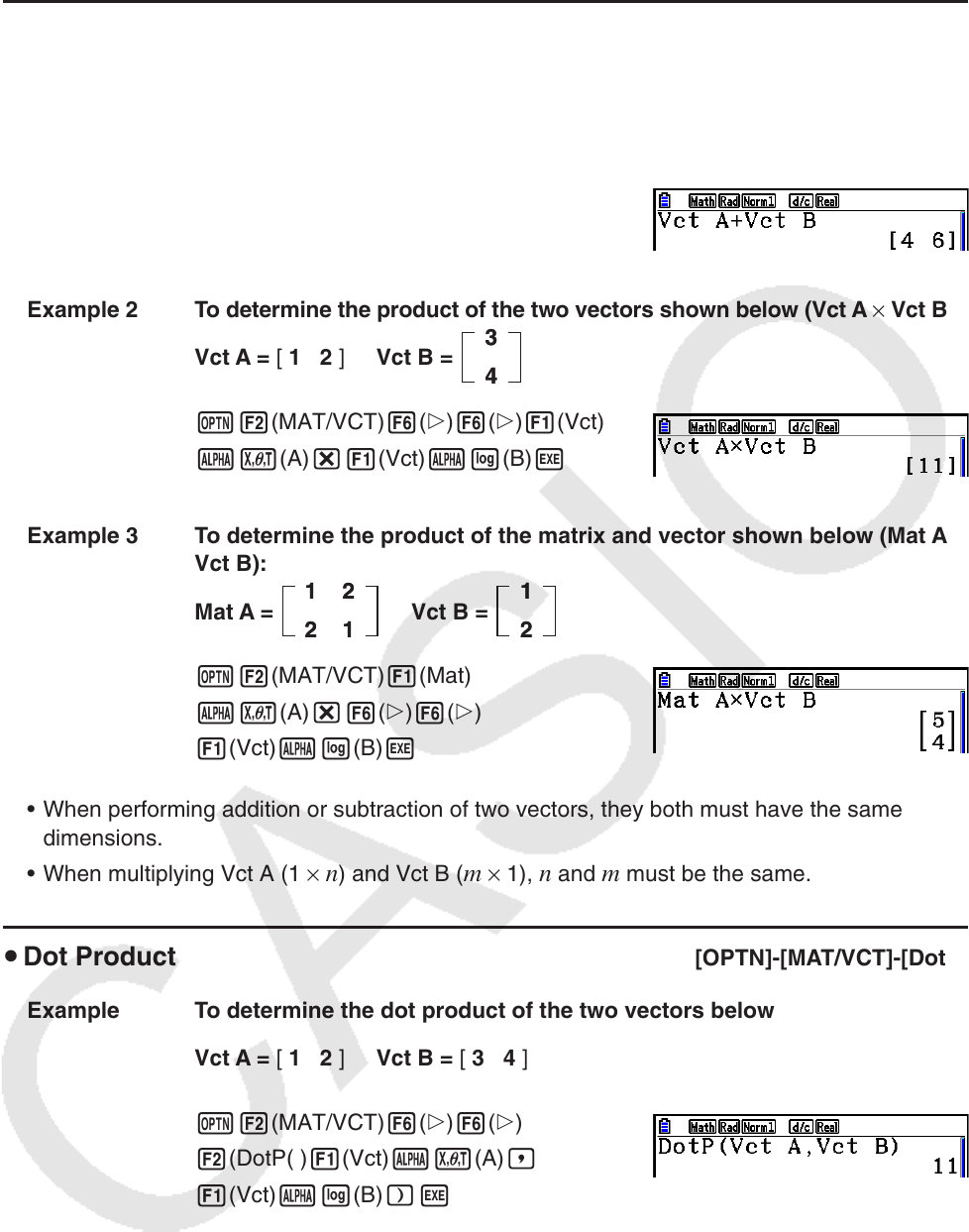User Manual
Table Of Contents
- Contents
- Getting Acquainted — Read This First!
- Chapter 1 Basic Operation
- Chapter 2 Manual Calculations
- 1. Basic Calculations
- 2. Special Functions
- 3. Specifying the Angle Unit and Display Format
- 4. Function Calculations
- 5. Numerical Calculations
- 6. Complex Number Calculations
- 7. Binary, Octal, Decimal, and Hexadecimal Calculations with Integers
- 8. Matrix Calculations
- 9. Vector Calculations
- 10. Metric Conversion Calculations
- Chapter 3 List Function
- Chapter 4 Equation Calculations
- Chapter 5 Graphing
- 1. Sample Graphs
- 2. Controlling What Appears on a Graph Screen
- 3. Drawing a Graph
- 4. Saving and Recalling Graph Screen Contents
- 5. Drawing Two Graphs on the Same Screen
- 6. Manual Graphing
- 7. Using Tables
- 8. Modifying a Graph
- 9. Dynamic Graphing
- 10. Graphing a Recursion Formula
- 11. Graphing a Conic Section
- 12. Drawing Dots, Lines, and Text on the Graph Screen (Sketch)
- 13. Function Analysis
- Chapter 6 Statistical Graphs and Calculations
- 1. Before Performing Statistical Calculations
- 2. Calculating and Graphing Single-Variable Statistical Data
- 3. Calculating and Graphing Paired-Variable Statistical Data (Curve Fitting)
- 4. Performing Statistical Calculations
- 5. Tests
- 6. Confidence Interval
- 7. Distribution
- 8. Input and Output Terms of Tests, Confidence Interval, and Distribution
- 9. Statistic Formula
- Chapter 7 Financial Calculation
- Chapter 8 Programming
- Chapter 9 Spreadsheet
- Chapter 10 eActivity
- Chapter 11 Memory Manager
- Chapter 12 System Manager
- Chapter 13 Data Communication
- Chapter 14 Geometry
- Chapter 15 Picture Plot
- Chapter 16 3D Graph Function
- Appendix
- Examination Mode
- E-CON4 Application (English)
- 1. E-CON4 Mode Overview
- 2. Sampling Screen
- 3. Auto Sensor Detection (CLAB Only)
- 4. Selecting a Sensor
- 5. Configuring the Sampling Setup
- 6. Performing Auto Sensor Calibration and Zero Adjustment
- 7. Using a Custom Probe
- 8. Using Setup Memory
- 9. Starting a Sampling Operation
- 10. Using Sample Data Memory
- 11. Using the Graph Analysis Tools to Graph Data
- 12. Graph Analysis Tool Graph Screen Operations
- 13. Calling E-CON4 Functions from an eActivity

2-62
u Vector Addition, Subtraction, and Multiplication [OPTN]-[MAT/VCT]-[Vct]
Example 1 To determine the sum of the two vectors shown below (Vct A + Vct B):
Vct A = [ 1 2 ] Vct B = [ 3 4 ]
K2(MAT/VCT)6(g)6(g)1(Vct)
av(A)+1(Vct)al(B)w
Example 2 To determine the product of the two vectors shown below (Vct A × Vct B):
Vct A = [ 1 2 ] Vct B =
K2(MAT/VCT)6(g)6(g)1(Vct)
av(A)*1(Vct)al(B)w
Example 3 To determine the product of the matrix and vector shown below (Mat A ×
Vct B):
Mat A = Vct B =
K2(MAT/VCT)1(Mat)
av(A)*6(g)6(g)
1(Vct)al(B)w
• When performing addition or subtraction of two vectors, they both must have the same
dimensions.
• When multiplying Vct A (1 ×
n) and Vct B (m × 1), n and m must be the same.
u Dot Product [OPTN]-[MAT/VCT]-[DotP]
Example To determine the dot product of the two vectors below
Vct A = [ 1 2 ] Vct B = [ 3 4 ]
K2(MAT/VCT)6(g)6(g)
2(DotP( )1(Vct)av(A),
1(Vct)al(B))w
3
4
3
4
1 2
2 1
1 2
2 1
1
2
1
2










